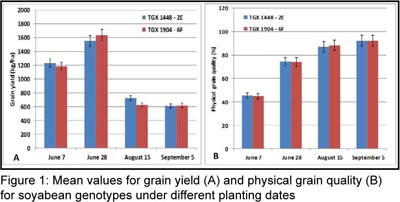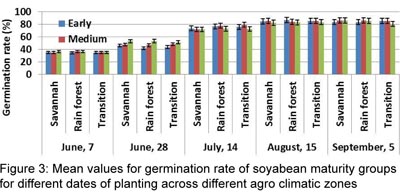Sierra Leone falls within the humid forest agro ecological zone. Based on meteorological data, type of vegetation, and length of growing period for crops under rain fed conditions, the country is divided into different agro climatic zones. As an incredibly versatile plant with different maturity groups, soyabean is adaptable to a wide range of climatic conditions. Date of planting exposes soyabean plants to environmental factors (water, temperature, relative humidity, and day length) that can adversely affect the growth and development of its vegetative and reproductive components under rain fed conditions. Water stress is the main limiting environmental factor that contributes to soyabean crop failure in Sierra Leone. Despite its high demand in the country, soyabean grain yields are low and the seed quality poor on smallholder farms.
With support from the N2Africa project, field trials were conducted to determine when and where to plant different maturity groups of in Sierra Leone in order to obtain optimum grain yields with good seed quality during the 2012 and 2013 cropping seasons. Delay in planting soyabean significantly affected the performance of TGX 1448-2E and TGX 1904-6F in the rain forest, transitional rain forest, and savannah agro climatic zones when planted on June 7, June 28, August 15, and September 5 during the 2012 cropping season. Date of planting significantly affected seed emergence, biomass yield, nodulation, and days to 50% flowering, grain yield and physical grain quality. Planting in June gave the highest grain yields, but with poor physical grain quality, whereas planting in August and September resulted in lower grain yields, but with good physical grain quality. Thus, a trade-off was observed between the quantity and the quality of grains produced (Figure 1).
|
In all agro climatic zones, date of planting also significantly affected grain yield, biomass and stover yield, number of field pods per plant, number of grains per pod and 100 grain mass of different maturity groups of soyabean when planted on June 7, June 28, July 14, August 15 and September 5 during the 2013 cropping season. A consistent decrease in mean values for grain yield was observed for the early (TGX 1951-3F), medium (TGX 1904-6F) and late (TGX 1448-2E) soyabean genotypes when planting was delayed after the June 28 in all agro climatic zones (Figure 2). All maturity groups of soyabean genotypes flowered early and were exposed to water deficit when planted late on August 15 and September 5 and consequently, had less time to develop vegetative and reproductive components. As a result, short soyabean plants with few branches and nodes with flowers, and relatively low number of filled pods per plant developed. In addition, water deficit during seed development significantly reduced the number of grains per pod and 100 seed mass. In all agro climatic zones, grain yield varied among soyabean maturity groups. However, the highest mean value (date of planting and agro climatic zone) for grain yield (1223 kg/ha) was obtained from early maturity soyabean type TGX 1951-3F. |
|
 |
To conclude, date of planting determines the soyabean grain yield and seed quality under rain fed conditions in Sierra Leone. For optimum grain yield and seed quality, mid July seems to be an appropriate date for farmers to plant different maturity groups of soyabean in the rain forest, savannah, and transitional rain forest agro climatic zones in Sierra Leone. Keiwoma Mark Yila |



